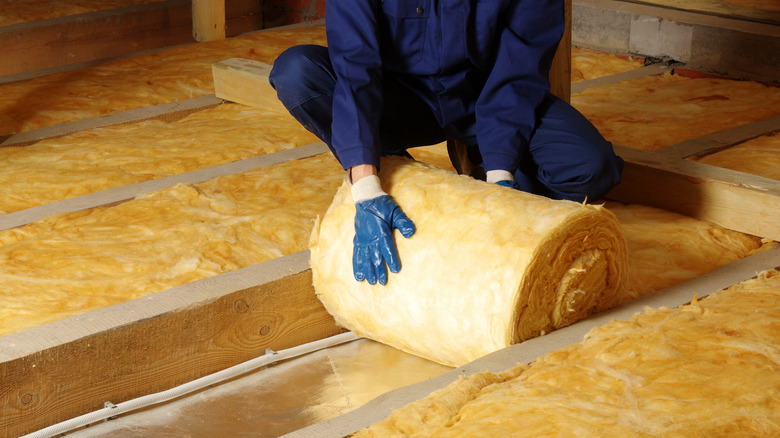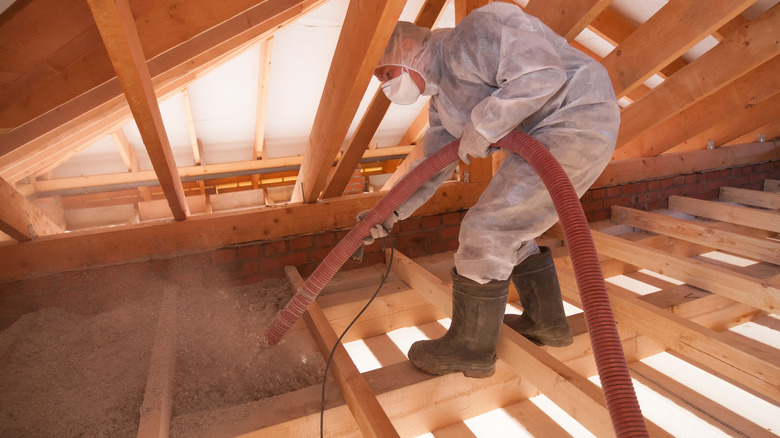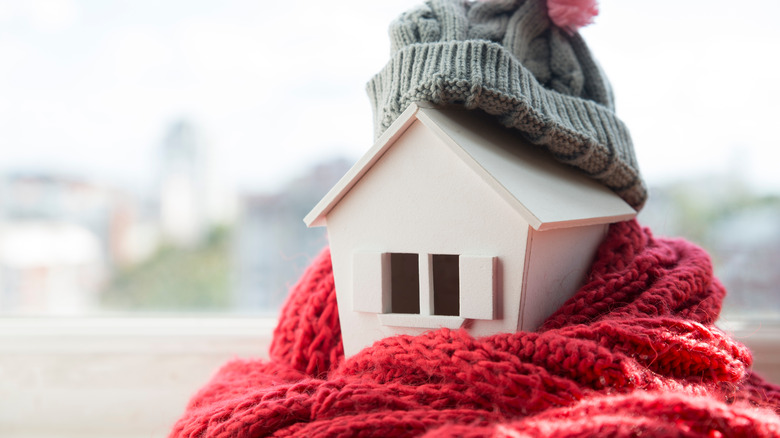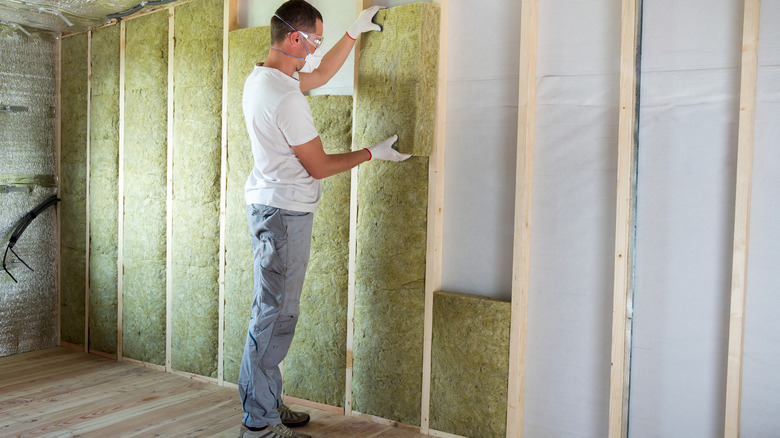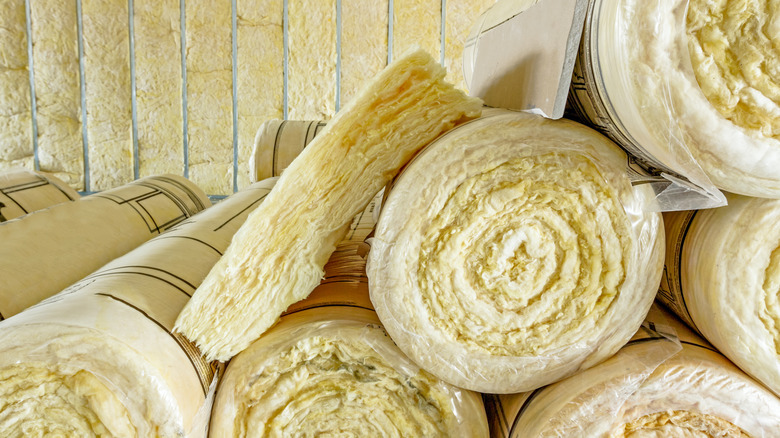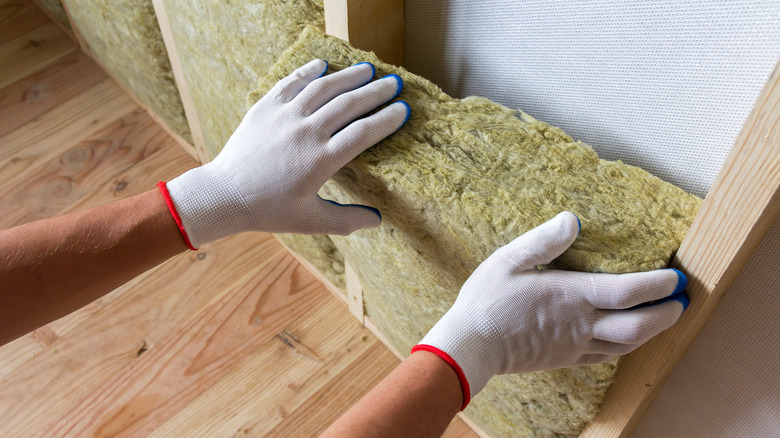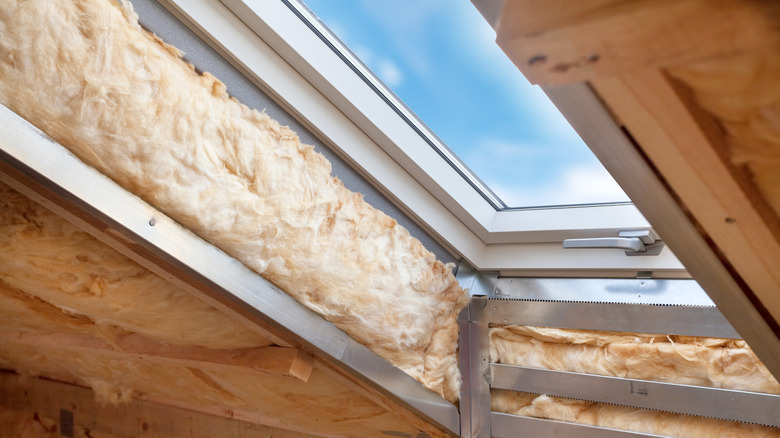What Is Insulation And Why Do You Need It In Your Home?
Insulation can be defined as any type of material that serves to provide a barrier within the walls, ceilings, and floors of a home and helps regulate temperature and noise, according to Energy.gov. If your home gets cold in the winter or hot in the summer, it is likely not properly insulated, as per RetroFoam of Michigan Inc. Other signs that your house could benefit from insulation include excessively high electric bills, cold floors and drafts in the winter, and needing to keep the furnace or air conditioner on at all times, depending on the season.
While most modern homes are built with insulation, many older homes lack this essential component. In fact, in-home insulation wasn't invented until the 1930s when researcher Dale Kleist accidentally figured out a way to create fiberglass insulation, as per PJ Fitzpatrick. Cellulose insulation was invented in the 1950s but only became widely used in the 1970s, while spray foam came about in the 1980s. Naturally, the quality and effectiveness of insulation have only improved with time and new technologies, and most modern-day insulation materials effectively protect your home against extreme temperature fluctuations.
If you're building a new home or looking to improve the one you already have, installing insulation will not only keep you comfortable year-round it will also save you money on heating and cooling costs. Is there anything better than that? The following guide will teach you everything you need to know about insulation and why you need it in your home.
How insulation works
Insulation works by interrupting the natural flow of heat that takes place within the home, as per Energy.gov. This can be understood by thinking about how heat travels. As a general rule, heat will always flow from a hotter location to a cooler location. For example, the reason your home gets hot during the summer is that heat moves from the outdoors through the walls, roof, and windows of your house into the interior spaces until the temperature becomes equalized. The same goes for the winter: heat flows from hotter rooms in your home, such as those you keep heated via a central heating system or individual radiator or fireplace, into rooms that aren't heated, such as basements, attics, and garages. The heat will also escape into the outdoors, where the temperature is understandably much lower. In both situations, you are required to either continuously cool or heat your home to make up for the gained or lost heat.
This is where insulation comes into play. Depending on the material you install, insulation will essentially block the flow of heat as it tries to either move from the outdoors to the indoors or escape from the indoors to the outdoors. Certain types of insulation also work to reflect the heat that hits them, either keeping it out of the home or maintaining it within the interior spaces.
How much insulation to use
When it comes to determining how much insulation to use in your home, you will need to understand the R-value of the area you live in and the corresponding R-value of the insulation material, according to Bob Vila. The R-value will be higher for regions where the temperature fluctuates more wildly throughout the seasons and lower in areas where temperatures stay relatively steady. In this vein, you will need insulation with a higher R-value if you live in a northern state that experiences colder winters. Energystar.gov featured a map of the U.S. with recommended R-values depending on the region of the country. Additionally, you can always consult with an insulation technician to determine your area's R-value.
Once you know the necessary R-value of the insulation material you will purchase, the next step is to calculate the total amount of insulation you will need per room or area in your home. Bob Vila offers a handy way to do this. Using a measuring tape, determine the height and width of any given wall in your home and then multiply those numbers. Once you subtract the area of any doors and windows, you will be left with the total square footage of insulation necessary to cover that wall. You can repeat this for all the walls in your house. This same calculation applies to floors and ceilings as well — you just won't need to subtract the area of windows or doors here.
Types of insulation materials
There are many different insulation materials on the market today. The one you choose for your home will depend on a variety of factors, including your total budget, the part of the home you're insulating (walls, roof, floors, etc.), and the amount of insulation you need, as per Cielo. In some cases, certain parts of your home can be insulated with one material, while other parts utilize a different material. However, this decision is made on a case-by-case basis.
One of the most common and versatile types of insulation is fiberglass, which is made of fine glass fibers that are condensed into sheets or rolls and installed in the framing of a home. Cellulose is another popular insulation material, consisting of recycled paper that is turned into fibers and typically air-blown into a space. You will also likely come across foam insulation, which is comprised of a variety of plastic materials and installed via several different methods, including foamboards, air blowing, and loose-fill.
If you're interested in a more natural insulation material, check out recycled cotton, wool, hemp, or straw, all of which are conveniently packaged in panels or rolls. One more insulation material is known as mineral wool, not to be confused with natural sheep's wool. Mineral wool is artificial and made from rock and metals. It can be purchased in rolls or loose fill.
Types of insulation installation
Insulation doesn't only come in a variety of materials, it is also installed in a number of different ways. These include loose-fill, foam board, batts, rolls, radiant barriers, and spray foam, according to Home Depot. Loose-fill insulation is exactly what it sounds like — the insulation is left loose and meant to be blown into a space. The advantage of this type of insulation is that it offers an alternative to more rigid forms of insulation that aren't conducive to smaller attics and crawl spaces. However, it can also be used to fill walls and floors. Foam board insulation consists of panels of hard foam and is great for larger areas of your home that measure evenly. The boards are sold in a variety of thicknesses without taking up too much space.
Batt insulation is one more way that insulation materials are sold. It is essentially a thick strip of insulation that is typically installed between the joists and studs of the wall, ceiling, and floor framing. Roll insulation is similar to batt insulation in that it is also a form of condensed and pre-cut materials, but instead of being sold in strips, it is sold in rolls. It is slightly more flexible than batt insulation as well. Spray foam is a type of insulation that is sprayed into a space and expands to fill in cracks and crevices. Finally, radiant barriers use aluminum foil, or another reflective material, to keep heat from entering the home.
How to install insulation
Each insulation type requires a different installation method. For batts, you'll want to cut to the desired width and length as you situate it in place, as per This Old House. You'll need to trim around barriers like electrical boxes or squeeze the batt behind pipes and wires. Roll insulation can be installed in a similar way. You'll roll out the insulation and cut it wherever necessary to fit it within the joists and studs of your home's framing, according to Home Tips. In both cases, you'll fasten the insulation with staples along the accompanying mounting tabs.
Installing loose-fill insulation is a bit more complicated and requires the use of a blower machine. You will also need to use a mask and protective goggles when carrying out this task. The process requires you to first seal off any air leaks with expanding foam before adding foam vent chutes, as per Family Handyman. Once you've marked the height to which you want to fill the space with insulation, you can get to work spraying it in with the blower.
For foam-board insulation, you will need to cut the desired height and width before setting the boards up along the walls and floors and stapling them to the framing, according to The Spruce. Spray foam is installed by filling any given space with the expandable foam using a specific piece of equipment that is typically sold with the insulation, as per Family Handyman.
Cost of insulation
The typical cost of insulating a 2,000-square-foot home can range anywhere from $3,000 to $10,000 depending on the insulation material and type used, according to Forbes. This averages out to around $1.50 to $5.00 per square foot. Before this number scares you away, note that insulating your home is an investment that pays off in the long run since you end up saving money on your energy bills. The costs also depend on whether your home is new or if you are adding or replacing pre-existing insulation in an older home. In the latter case, you will need to add the costs of tearing out the insulation to the costs of purchasing new insulation.
The cheapest types of insulation are batts and rolls, which range from $0.65 to $2.00 per square foot (via Forbes). Loose-fill insulation is slightly pricier at between $1.65 and $3.80 per square foot. Next up is foam board insulation, which can set you back around $3.15 to $7.50 per square foot. The price of spray foam insulation is calculated a bit differently, as per Angi. You can expect to pay between $0.44 and $1.50 per board foot, which is defined as a one-square-foot area of space with a one-inch layer of foam.
Keep in mind that unless you are installing your insulation yourself, you will need to factor in hired labor costs. Forbes reveals that most professionals charge between $0.25 and $2.50 per square foot.
Benefits of insulating your home
There are a couple of main benefits to insulating your home that makes it worth any expense and potential hassle. According to Energystar.gov, the EPA has come out with data that shows insulated houses save homeowners around 15% on heating and cooling expenses. This also works out to around 11% savings on total energy expenditures. These savings only increase in northern regions of the country, where people can save up to 20% on heating and cooling costs. Even if you opt for pricier insulation types, you are sure to pay off the installation costs in less time than you think and continue to save money over the years.
Not only will insulation save you money on energy bills, but it will also increase the market value of your home, as per Alpine Insulation. Energy-efficient homes are a major selling point for many buyers. It has also been shown that houses with insulation spend less time on the market than their non-insulated counterparts. If your home has properly installed and updated installation, buyers will pay more to benefit from increased energy savings, comfortable temperatures year-round, and increased air quality. Another bonus is not having to install the insulation themselves, which comes out pricier in the long run with the added costs of ripping out walls and floors.
